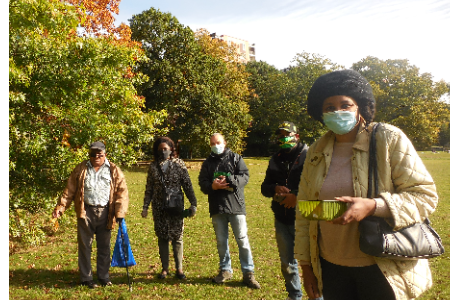
This project supports people in their recovery from mental and ill-health by providing encouragement to enjoy outdoor spaces, along with access to a supportive and inclusive environment. People with different degrees of ill health are brought together with volunteers and members of the community to promote inclusion, reduce prejudice, and strengthen resilience through coming together.
Walks are organised on a weekly, fortnightly or monthly basis to visit sites of local or historical interest, parks or community gardens, public art exhibitions and other public spaces. Participants are led through stretches, breathing exercises and mindfulness activities. Participants are also encouraged to reflect on their adventures through creative means such as arts and crafts, online blogs or paper-based walking journals. This can be done on a weekly, monthly or quarterly basis, depending on interest from participants.
As group members grow in confidence, they can be provided with the option to support the Group Leader to plan and lead walks. Walk Leader Training can be offered, along with map reading or first aid skills for those keen to stay involved in the activity.
Target audience and engagement
- The key target audience can be wide ranging, from those with physical and non-physical health problems, to socially isolated people, disabled people, over-60s or individuals and families from deprived backgrounds
- Encouraging referrals from GP’s, social prescribing link workers, mental health professionals and partner organisations can be a great way to engage participants
- Promote your project by hosting or attending events and using publicity materials, such as leaflets or posters
- Use existing community group networks, or seek out specialist and charity organisations who work with your target group, to raise awareness of your activities
- Engagement can also be through social media, with specific targeting to potential user groups
- Word of mouth is especially effective for the older generations. As your project goes on, ask your participants to spread the word about the project
Reach
- Small (30 – 50 participants)
- Geographically - anywhere there are green, open spaces, footpaths and walkways. Example spaces include, parks and woodlands, river and canal paths, estates, managed gardens, or other open spaces
Equipment needed
- Walking resources including maps, worksheets and activity packs (if needed)
- Hi-Vis vest
Resources needed
- Project Leader:
-Oversee the project, ensure the participants feel safe and enjoy their experience
-Track equipment and ensure it is returned
-Ensure all funding criteria and documentation is met
-Run risk assessment for safeguarding, injuries and identify any other concerns which may affect project delivery
-Gather feedback from participants to feed into future sessions and projects
-The project lead should have the requisite level of DBS, understand health and safety needs and preferably be first aid trained - Volunteers/Project Officers:
-Help answer queries
-Contribute to overseeing activity and resolve any equipment issues
-Run or support the running of scheduled walks - Storage Space:
-You will need somewhere to store equipment. This could be at a community centre, in an existing office, or perhaps another local business that has a storage facility - Publicity:
-Flyers and posters for publicity of the sessions - Refreshments:
-Tea, coffee and snacks at every session, this will lighten the mood and offers an incentive for people to come. This may include stopping off for refreshments at a café along the walking route, or bringing your own as part of a picnic event built into the walk plan
Estimated project costs
- Project lead, administrative and management costs £3,000
- Oyster cards for volunteer travel costs £180
- Oyster cards for co-worker travel costs £1,620
- Public liability insurance (if needed) £170
Top tips/key learnings
- Ensure that the volunteers used to lead the walks are enthusiastic and engaging to ensure people return for future events
- Take advantage of the training programme that is offered by Walking and Cycling Grants London
Maximising local contacts
- Make connections with local partners and London based organisations to discover new walking routes that local residents may not have explored before. Organisations such as London Wildlife Trust, Quaggy Waterways Action Group, Friends of Brookmill Park, WaterLink Way and Lewisham Biodiversity can help you to get started
- Engage with your local council - they may be able to lend you equipment, help market the project, or help secure a local space for meetings. They may also be able to refer participants to your project and share learnings on previous projects
This project idea was provided by Sydenham Garden - Twitter - Facebook
If you decide to run your own version of this project in your community, please email us at wcgl@groundwork.org.uk. We love to hear that we are inspiring people to walk and cycle.